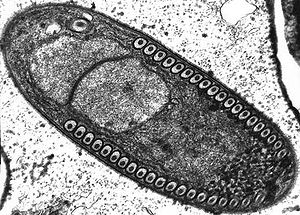오피스토스포리디아
|
| ||
|---|---|---|
 Fibrillanosema crangonycis(미포자충류)의 포자모세포 | ||
| 생물 분류ℹ️ | ||
| 역: | 진핵생물 | |
| (미분류): | 단편모생물 | |
| (미분류): | 오바조아 | |
| (미분류): | 후편모생물 | |
| (미분류): | 홀로미코타 | |
| (미분류): | 주스포리아 | |
| (미분류): | 오피스토스포리디아 (Opisthosporidia) Karpov et al., 2014[1] | |
| 군 | ||
|
| ||
오피스토스포리디아(Opisthosporidia) 또는 균류(Fungi)는 자매군 크리스티디스코이데아와 함께 홀로미코타 분류군을 형성한다. 기저 분류군으로 BCG2(basal clone group 2)가 있다.[2][3] 오피스토스포리디아의 다른 기저 분류군은 진균류와 함께 분류되는 아펠리디움문(Aphelida)이고, 나머지는 로젤라아계(Rozellomyceta)와 결합되어 있는 BCG1(basal clone group 1) 분류균이다.[1][4][5][6] 역사적으로 진균류는 오피스토스포리디아에서 출현한 것으로 간주되지 않았다. 즉 아펠리디움문과 크립토미코타(은진균류(隱眞菌類), Cryptomycota 또는 Rozellomycota)의 마지막 공통 조상으로 간주되지 않았다.
계통 분류[편집]
다음은 후편모생물의 계통 분류이다.[7][8][9][10]
| 후편모생물 |
| ||||||||||||||||||||||||||||||||||||||||||||||||||||||||||||||||||||||||||||||||||||
각주[편집]
- ↑ 가 나 Karpov, Sergey; Mamkaeva, Maria A.; Aleoshin, Vladimir; Nassonova, Elena; Lilje, Osu; Gleason, Frank H. (2014년 1월 1일). “Morphology, phylogeny, and ecology of the aphelids (Aphelidea, Opisthokonta) and proposal for the new superphylum Opisthosporidia”. 《Aquatic Microbiology》 5: 112. doi:10.3389/fmicb.2014.00112. PMC 3975115. PMID 24734027.
- ↑ Tedersoo, Leho; Sánchez-Ramírez, Santiago; Kõljalg, Urmas; Bahram, Mohammad; Döring, Markus; Schigel, Dmitry; May, Tom; Ryberg, Martin; Abarenkov, Kessy (2018). “High-level classification of the Fungi and a tool for evolutionary ecological analyses”. 《Fungal Diversity》 (영어) 90 (1): 135–159. doi:10.1007/s13225-018-0401-0. ISSN 1560-2745.
- ↑ Torruella, Guifre; Grau-Bove, Xavier; Moreira, David; Karpov, Sergey A.; Burns, John; Sebe-Pedros, Arnau; Volcker, Eckhard; Lopez-Garcia, Purificacion (2018년 5월 25일). “The transcriptome of Paraphelidium tribonemae illuminates the ancestry of Fungi and Opisthosporidia”. 《bioRxiv》 (영어): 233882. doi:10.1101/233882.
- ↑ Silar, Philippe (2016). “Protistes Eucaryotes: Origine, Evolution et Biologie des Microbes Eucaryotes”. 《HAL Archives-ouvertes》: 1–462.
- ↑ Bass, David; Czech, Lucas; Williams, Bryony A. P.; Berney, Cédric; Dunthorn, Micah; Mahé, Frederic; Torruella, Guifré; Stentiford, Grant D.; Williams, Tom A. (2018년 4월 28일). “Clarifying the Relationships between Microsporidia and Cryptomycota”. 《Journal of Eukaryotic Microbiology》 (영어) 65 (6): 773–782. doi:10.1111/jeu.12519. ISSN 1066-5234. PMC 6282948. PMID 29603494.
- ↑ Berbee, Mary L.; James, Timothy Y.; Strullu-Derrien, Christine (2017년 9월 8일). “Early Diverging Fungi: Diversity and Impact at the Dawn of Terrestrial Life”. 《Annual Review of Microbiology》 (영어) 71 (1): 41–60. doi:10.1146/annurev-micro-030117-020324. ISSN 0066-4227. PMID 28525299.
- ↑ Peterson, Kevin J.; Cotton, James A.; Gehling, James G.; Pisani, Davide (2008년 4월 27일). “The Ediacaran emergence of bilaterians: congruence between the genetic and the geological fossil records”. 《Philosophical Transactions of the Royal Society of London B: Biological Sciences》 363 (1496): 1435–1443. doi:10.1098/rstb.2007.2233. PMC 2614224. PMID 18192191.
- ↑ Parfrey, Laura Wegener; Lahr, Daniel J. G.; Knoll, Andrew H.; Katz, Laura A. (2011년 8월 16일). “Estimating the timing of early eukaryotic diversification with multigene molecular clocks”. 《Proceedings of the National Academy of Sciences》 108 (33): 13624–13629. doi:10.1073/pnas.1110633108. PMC 3158185. PMID 21810989.
- ↑ Hehenberger, Elisabeth; Tikhonenkov, Denis V.; Kolisko, Martin; Campo, Javier del; Esaulov, Anton S.; Mylnikov, Alexander P.; Keeling, Patrick J. (2017). “Novel Predators Reshape Holozoan Phylogeny and Reveal the Presence of a Two-Component Signaling System in the Ancestor of Animals”. 《Current Biology》 27 (13): 2043–2050.e6. doi:10.1016/j.cub.2017.06.006. PMID 28648822.
- ↑ Tedersoo, Leho; Sanchez-Ramırez, Santiago; Koljalg, Urmas; Bahram, Mohammad; Doring, Markus; Schigel, Dmitry; May, Tom; Ryberg, Martin; Abarenkov, Kessy (2018년 2월 22일). “High-level classification of the Fungi and a tool for evolutionary ecological analyses”. 《Fungal Diversity》 90 (1): 135–159. doi:10.1007/s13225-018-0401-0.
- ↑ 가 나 BCG1 = basal clone group 1, BCG2 = basal clone group 2
